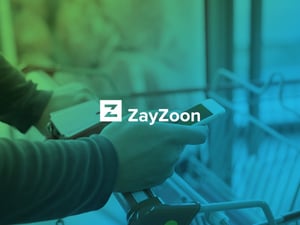
Understanding Bank Fees
 Tate Hackert
Tate Hackert
Tate is the brain behind ZayZoon, developing the idea of providing access to funds before payday, in 2013. He feels gratified knowing “we get to improve the financial health of people each and every day.” One of his favourite ZayZoon experiences involves a business trip to Selinsgrove, Pennsylvania where he helped film a Holiday Inn Express testimonial video. Wearing a ZayZoon shirt at the local Walmart, someone saw Tate and exclaimed, “Hey, ZayZoon! I use that!"
“Compound interest is the eighth wonder of the world. He who understands it, earns it … he who doesn’t … pays it.” – Albert Einstein
The little things in life add up…quickly. Compounding can be good, but it can also be bad. A few knee injuries here and there over time add up to be a constant knee problem. A few steps on a carpet every day eventually make for a worn-down carpet. The same compounding can happen to your bank account.
Fees associated with your bank account may seems small but can quickly accumulate into a financial mess if you’re not careful. To help you avoid that financial mess, we’ve compiled a brief overview of a few fees you may encounter with your bank.
Maintenance Fees
These are fees that you have to pay in order to keep your account open and running. They come in monthly or yearly installments. Essentially, you’re paying the bank to hold on to your money.
How much they’re costing you: Maintenance fees, according to Chime Bank, often range from $10 – $15 per month. That’s about $120 – $180 per year.
How to avoid this fee: There are two ways to avoid paying monthly or yearly maintenance fees.
- Work with a financial institution that doesn’t require a maintenance fee. NerdWallet is a great resource for finding a bank offering free checking accounts.
- Many if not most banks will eliminate their maintenance fee if you meet certain deposit and/or usage requirements. These requirements typically include a direct deposit minimum, a minimum monthly balance or meet a monthly debit card transaction amount.
ATM Fees
These fees a fairly straight forward. Use an ATM and you’ll get charged a fee for using that ATM. The fees you need to pay attention to come from two types of ATMs: banks that you don’t have an account with and business-ran ATMs (gas stations, bars, movie theaters, etc.).
How much they’re costing you: According to InvestorPlace.com, “the average that a customer pays in 2017 when withdrawing from a bank they have no account with is $4.69.” If you stop by the ATM 2 days a week, you’re paying about $40 per month to access your money. $40 FOR YOUR OWN MONEY!
That amount can be even higher when dealing with different businesses that have ATMs inside of their establishments. Be especially careful when travelling and when pulling money from areas of desperation such as tourist areas, bars, and arenas. Some may charge $1 to use the ATM while others may charge up to $8 or higher. Those fees can add up quickly if you’re not careful.
How to avoid this fee: ATM fees can be a thing of the past if you plan accordingly. Here’s how:
- Withdrawal the amount of cash you need for the week from a bank that you have an account with. Not only will this help you avoid ATM fees, but it will also help you create and follow a budget.
- Work with a bank that has no ATM fees or offers to reimburse you for fees picked up from outside ATMs. Investopedia has a helpful list of banks that have no ATM fees or reimbursement programs.
Overdraft Fees
According to the Consumer Financial Protection Bureau (CFPB), in 2016, Americans paid $15 billion in overdraft fees. That’s a lot of money.
So, what is an overdraft fee? They’re fees charged when you try to withdrawal an amount larger than the amount you actually have in your account. For example, if you write a check for $200 and you only have $150 in the bank, you’ll likely be charged an overdraft fee.
How much they’re costing you: CFPB Director Richard Cordray explains that “banks often charge fees of around $34 for each overdraft incident.”1 That $34 may seem like a manageable amount, but like any other fee, it can add up quickly and hurt your wallet.
How to avoid this fee: With a little planning and with a proactive mindset, you can avoid these fees. Here’s a few ways you can do that, courtesy of Credit.com.
- Check your bank account regularly. Knowing how much you have in your checking account at all times can go a long way to ensure you don’t write any bounced checks.
- Sign up for automatic alerts. You can sign up for alerts (email, text, push notifications, etc.) with your bank that tell if your account drops below a specific dollar amount. (This is actually something www.zayzoon.com offers, along with number 1) Hint*Hint*
- Keep a safety net. If need be, a safety net would allow you to transfer money to your checking account quickly and easily. This net could be a savings account or another account that allows immediate transfers of your money.
Paper Statement Fees
Simply put, banks may charge you to receive a paper bank statement.
How much they’re costing you: According to the Two Cents financial blog, bank customers are paying “$1 to $5 for opting into paper statements rather than the electronic versions.” This may not be a large amount, but the fact is that you’re throwing away $5 a month for snail mail.
How to avoid this fee: It’s easy. Log in to your online bank account and edit your statement delivery preference to “paperless.” You’ll save yourself money and you’ll save some trees.
There are other, rarer fees that you may come across while working with your bank. It’s important that you understand every fee that you may be charged before you sign up for a new account. The most common trend here is that each fee seems manageable (albeit unnecessary) by itself, but it is very easy to be overcome with banking fees and experience a very negative compounding effect on your finances.
To learn more about how ZayZoon can help, visit our blog here.





